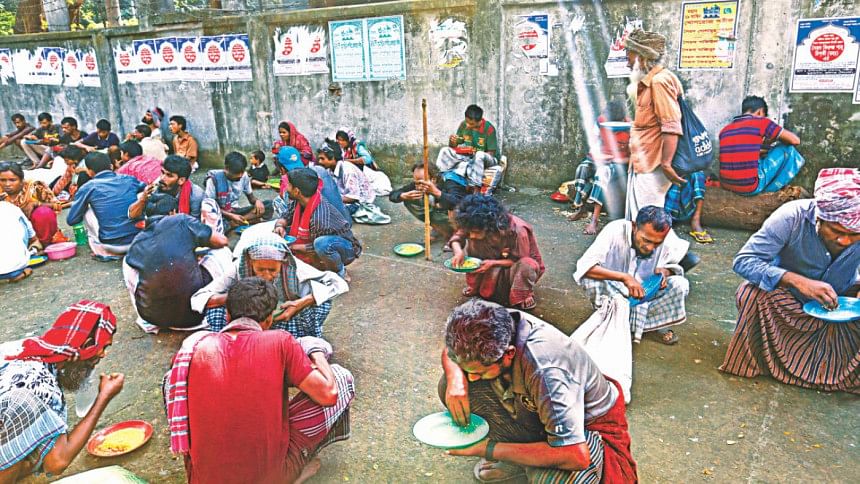Where no one is refused lunch

As the sun beat down on the capital at around 1:00pm yesterday, sexagenarian Khijir Ahmed was seen looking for a spot to sit under the shade of a tree inside the High Court mazar (shrine), waiting for Zuhr prayers to be over.
Since he came to the city from Jamalpur two days ago, he has been coming to the shrine, where several hundred people are served khichuri (hodgepodge) for lunch every day.
According to the World Food Programme, one in every nine persons around the world -- around 821 million people -- still goes to bed on an empty stomach every night.
Today is World Food Day, with this year's theme being “Our Action Our Future: A Zero Hunger world by 2030 is possible”. The international community has committed to end hunger, achieve food security and improve nutrition by 2030.
The day is observed marking the founding of Food and Agriculture Organization of the United Nations in 1945. It is also observed by other organisations concerned with food security, including the World Food Programme and the International Fund for Agricultural Development.
Khijir lost his job at a dyeing factory a year ago, and comes to Dhaka every now and then looking for work, but cannot find permanent employment due to old-age complications. He is the sole bread-earner of his family -- his wife and a disabled son.
“No one gives me work, not even as a security guard. I am quite strapped for cash, so I have decided to eat here from now on,” said Khijir.
Md Emon, 22, has been having lunch at the shrine for several months. He works as an assistant to caterers at wedding ceremonies.
“I earn Tk 200-300 per week when I have work, and when I don't, I have to eat here during lunch, or else it would be impossible for me to survive,” said Emon.
Among those eating at the shrine are women, many of them abandoned by their husbands.
Farzana Akhter, who was divorced three months ago, comes every day to have lunch with her one-year-old.
“My husband was already married to someone else before he married me. Now I do not have any steady job. So I come here for lunch,” said Farzana, who lives near the shrine now.
However, not everyone who eats at the shrine do it out of helplessness. Some prefer to eat here with the hope of receiving blessings of the shrine.
“I have a land-related case pending at the court. I want to have lunch here for good luck,” said Sheikh Harun from Faridpur.
Kamrul Hasan, a staffer of the shrine working for several years, said, “People of all ages gather here during lunch, and we refuse no one. People from different professions come to the shrine, out of respect and belief in the spirituality of the shrine.”
The High Court mazar committee is in charge of preparing and distributing the food. According to the committee's accountant Md Asaduzzaman, the committee feeds people every day as per tradition of the mazar.
As many as 300-400 people eat here on busy days, he said, adding that 15kg rice, 10kg meat, 2kg daal, 1kg onion, 2kg oil and spices ares used on an average per day. The funds come from donations.
The shrine commemorates Khwaja Sharfuddin Chishti, a 13th-century Muslim saint. It is said that he took shelter at this place when he came to this region to propagate Islam. Since then, this place is revered as his shrine.
According to a publication of the Supreme Court Mosque and Mausoleum Administration committee, the shrine came under the management of the
erstwhile High Court in 1964. Currently, a 10-member committee oversees its operations.

 For all latest news, follow The Daily Star's Google News channel.
For all latest news, follow The Daily Star's Google News channel. 



Comments